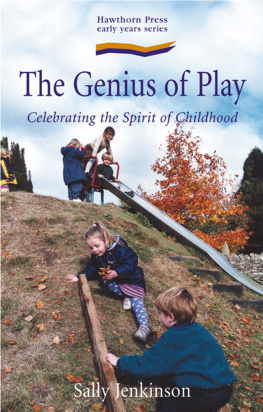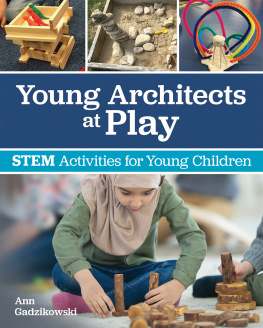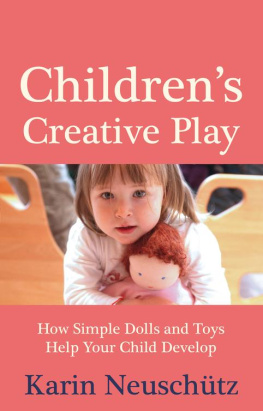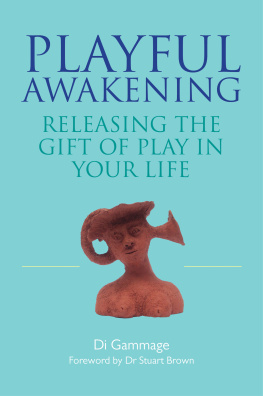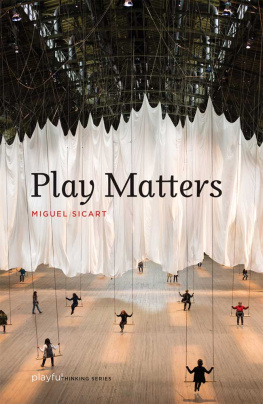The Genius of Play
Celebrating the Spirit
of Childhood
Sally Jenkinson

The Genius of Play Copyright 2001 Sally Jenkinson
Sally Jenkinson is hereby identified as author of this work in accordance with Section 77 of the Copyright, Designs and Patent Act, 1988. She asserts and gives notice of her moral right under this Act.
Published by Hawthorn Press, Hawthorn House, 1 Lansdown Lane, Stroud,
Gloucestershire, GL5 1BJ, UK
Tel: (01453) 757040 Fax: (01453) 751138
www.hawthornpress.com
All rights reserved. No part of this book may be reproduced, stored in a retrieval system or transmitted in any form by any means (electronic or mechanical, through reprography, digital transmission, recording or otherwise) without the prior written permission of the publisher.
Cover photograph by Charlie Bryan and Lucy Craven
Cover design by Hawthorn Press
Typesetting by Hawthorn Press, Stroud, Glos.
Reprinted 2004, 2008, 2010, 2012
Printed in 2015 by Melita Press, Malta.
Grateful acknowledgment to:
The Kunst historisches Museum, Vienna, Austria, for Kinderspiele by Pieter Breugel. The Open University Press for colour photograph of boys playing with wood. Harpers Weekly 11 Oct 1873, Massachusetts Historical Society for Shipbuilding, Gloucester Harbour by Winslow Homer. The Winterthur Library: Printed Book and Periodical Collection for the drawing from Childrens Delight: Bright Stories for Boys and Girls, Boston, 1889. Emma Aylett for her photographs of the Steiner Waldorf Kindergarten, North London.
Every effort has been made to trace the ownership of all copyrighted material. If any omission has been made, please bring this to the publishers attention so that proper acknowledgment may be given in future editions.
British Library Cataloguing in Publication Data applied for
ISBN 978-1-903458-04-4
eISBN 978-1-907359-67-5
genius: attendant, tutelary spirit etc.
Oxford English Dictionary
Article 31 of The Convention on the Rights of the Child (adopted by the General Assembly of the United Nations, November 20, 1989). states:
| Parties recognise the right of the child to rest and leisure, to engage in play and recreational activities appropriate to the age of the child and to participate freely in cultural life and the arts. |
| Parties shall respect and promote the right of the child to participate fully in cultural and artistic life and shall encourage the provision of appropriate and equal opportunities for cultural, artistic, recreational and leisure activity. |
The Genius of Play is a well-researched book that makes a valuable contribution to the worldwide debate about childhood. Play lies at the heart of childhood and this book deepens our understanding and appreciation of the crucial benefits of play. Herein lie the roots of our capacity to act socially, exercise our imaginations, develop emotional literacy and face new intellectual challenges. The author also shows how play deprivation, from which many of our children suffer now, is a threat to our well being. For all those who are seriously concerned about our children this is essential reading.
Christopher Clouder, Alliance for Childhood
Sally has a genius for perceiving the essence of childhood. Her examples of children at play are charming but also profound, for they show us the depths of play and the tremendous significance of play in human life. She balances anecdotes with the insights of major educators, psychologists and child advocates revealing a rich world of literature and organizations devoted to the importance of childrens play. In a time when childhood is endangered and play is a dying art this book serves children well and offers much help to adults struggling to understand the power of play.
Joan Almon
This is a book which many who work with play will find useful and challenging. Sally Jenkinson forays into play times past and in so doing raises concerns about play times present. The recollections of play provide an important historical lens through which to reflect upon opportunities and accomplishments of childrens play today. Sallys deep commitment to the integrity of play will also provide fuel to the debate about 21st century technologically prescribed play as an inhibitor of childrens freedom to construct the world for themselves.
The Genius of Play encourages educators to attend to childrens intentions as they watch them play, to try to understand what it is that children are working out. It encourages us to allow the spirit of play to come through in the way we provide space (in all its dimensions) for children to play with freedom.
This is an important addition to the growing collection of books which address the theme of play today. Sally Jenkinson encourages us to attend to play in the whole of childrens lives, as well as in their early preschool and school experiences. It deserves to be widely read and will generate lively debate amongst early childhood educators.
Dr. Cathy Nutbrown
The University of Sheffield, School of Education
Contents
List of Illustrations
Thanks
Thanks to the three children of the past, Lesley Gray, John Arnold and Brian Agg, who will recognise themselves in the following chapters, and to all the other children whose words, deeds and images live between the covers of this book.
Thanks to all my colleagues and friends and to my husband Angus and my three children, Derwin, Hamish and Emily.
Foreword
by Mary Jane Drummond
What kind of a book is this? An invitation to remember ones own childhood and play; a scholarly and multi-disciplinary review of relevant research; a powerful argument for the significance of play in human development; a treasury of attentive observations of childrens play, past and present; a passport to the realm of the subjunctive, where might and could, perhaps and what if? take precedence over the present indicative; a survival guide for the adult who is committed to the cause of childhood; a set of unforgettable snapshots of childrens lives The Genius of Play takes all these parts, and more, many more.
Sally Jenkinson makes an early move in establishing the grand theme of the book; in her opening pages she introduces the reader to the metaphor of journey as a way of understanding what it is that children do, in their passage through time, from the here-and-now immediacy of their play with dens, dolls and dressing up clothes, on the way to their undefined and unpredictable futures. But it is not a simple route map that she offers; this book is in no sense a set of directions for swiftly moving from A to B, from young to old, from little to big, from incapable to competent, from illiterate to literate, from child to adult. There are multiple pathways through the world of childrens play: the chapter headings indicate some of the important milestones that readers will pass as they trace the footsteps of the child, of all children, who are uncomplicatedly committed to their journey, without knowing in the least where it will lead them. It is Sally Jenkinsons particular talent that she never loses sight of the complexities of play; she trounces the benevolent educators attempt to kidnap the spontaneity of play for a pre-specified learning objective, and spurns the triviality of what she categories as wrap-around play, a contemptuous phrase for the kind of play that is shaped and defined by official directives.

